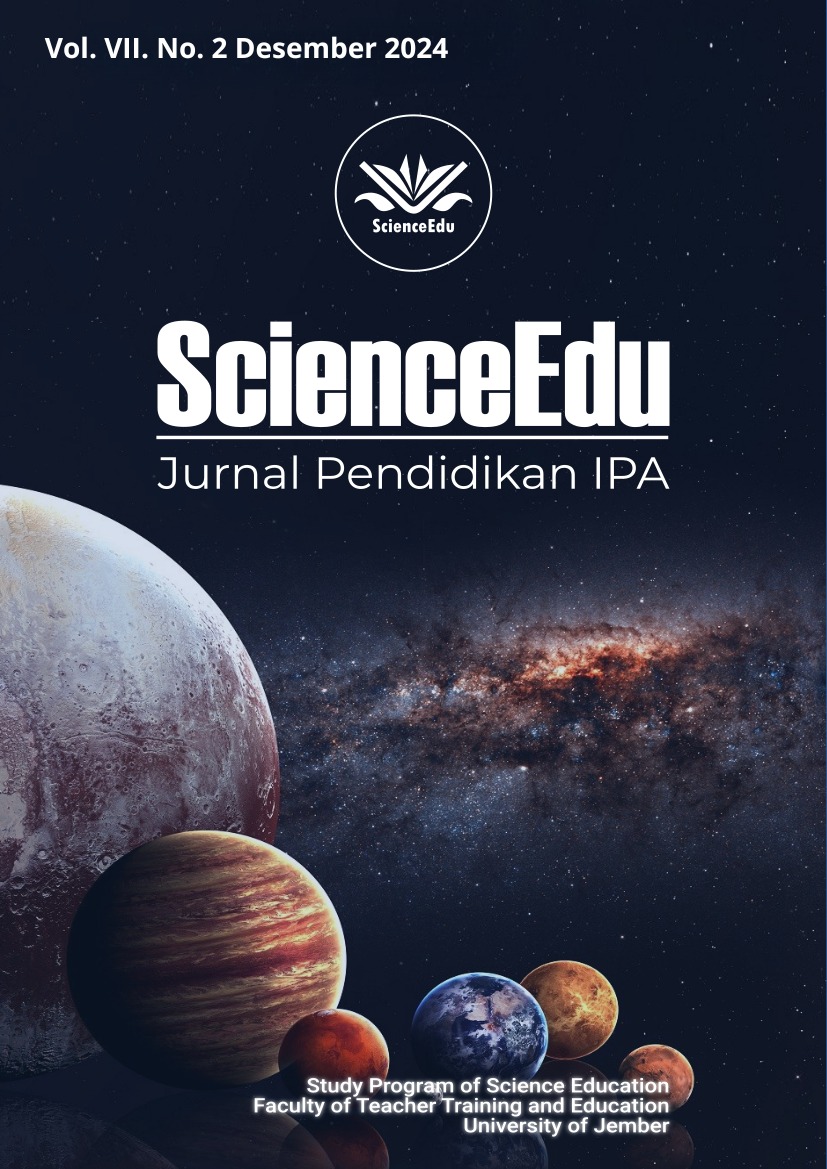Penggunaan Animasi stop-motion oleh Siswa SMP dalam Mengembangkan Pemahaman Konsep Energi
Abstract
Dalam pendidikan fisika, banyak konsep abstrak seperti energi tidak dapat diamati secara langsung, sehingga memerlukan metode pengajaran yang secara efektif menyampaikan ide-ide abstrak tersebut. Studi ini mengeksplorasi bagaimana siswa yang membuat animasi stop-motion dapat membantu mengembangkan pemahaman mereka tentang konsep energi. Dengan menggunakan pendekatan studi kasus kualitatif, metodologi penelitian ini melibatkan lima tahap: persiapan, pengenalan, pengenalan fenomena, pembuatan animasi, dan diskusi. Temuan menunjukkan bahwa keterlibatan siswa dalam animasi stop-motion memfasilitasi pengembangan pemahaman mereka tentang konsep energi. Penelitian ini menyoroti bahwa kreasi desain fase oleh siswa membantu mereka memvisualisasikan aspek energi momen demi momen dalam gerakan bola tenis, yang menumbuhkan pemahaman yang beragam di antara siswa. Selain itu, penelitian ini menggarisbawahi peran proses chunking dan sequencing dalam meningkatkan pemahaman konseptual siswa.
Downloads
References
Bachtiar, R. W., Meulenbroeks, R. F. G., & van Joolingen, W. R. 2021. Stimulating Mechanistic Reasoning in Physics Using Student-Constructed stop-motion Animations. Journal of Science Education and Technology. 30(6): 777–790. https://doi.org/10.1007/s10956-021-09918-z.
Bachtiar, R. W., Meulenbroeks, R. F. G., & van Joolingen, W. R. 2024. Understanding how student-constructed stop-motion animations promote mechanistic reasoning: A theoretical framework and empirical evidence. Journal of Research in Science Teaching. 61(2): 289–318. https://doi.org/https://doi.org/10.1002/tea.21891.
Bächtold, M. 2018. How Should Energy Be Defined Throughout Schooling? Research in Science Education. 48(2): 345–367. https://doi.org/10.1007/s11165-016-9571-5.
Bakri, F., Wahyuni, Permana, A. H., & Sumardani, D. 2021. Textbook Enriched with Video Augmented Reality: Contextual in Motion Concept Learning in Junior High School. AIP Conference Proceedings. 2320(March). https://doi.org/10.1063/5.0037614.
Berg, A., Orraryd, D., Pettersson, A. J., & Hultén, M. 2019. Representational challenges in animated chemistry: self-generated animations as a means to encourage students’ reflections on sub-micro processes in laboratory exercises. Chemistry Education Research and Practice. 20(4): 710–737. https://doi.org/10.1039/C8RP00288F.
Chen, R. F., Eisenkraft, A., Fortus, D., Krajcik, J., Neumann, K., Nordine, J., & Scheff, A. 2014. Teaching and learning of energy in K-12 education. Teaching and Learning of Energy in K-12 Education. 1(1): 1–379. https://doi.org/10.1007/978-3-319-05017-1.
Hoban, G., & Nielsen, W. 2010. The 5 Rs: A new teaching approach to encourage slowmations (student-generated animations) of science concepts. Teaching Science. 3(3): 33–38.
Kubsch, M., Nordine, J., Fortus, D., Krajcik, J., & Neumann, K. 2020. Supporting Students in Using Energy Ideas to Interpret Phenomena: The Role of an Energy Representation. International Journal of Science and Mathematics Education. 18(8): 1635–1654. https://doi.org/10.1007/s10763-019-10035-y.
Kubsch, M., Opitz, S., Nordine, J., Neumann, K., Fortus, D., & Krajcik, J. 2021. Exploring a pathway towards energy conservation through emphasizing the connections between energy, systems, and fields. Disciplinary and Interdisciplinary Science Education Research. 3(1): 2. https://doi.org/10.1186/s43031-020-00030-7.
Opitz, S. 2015. Students’ Energy Concepts at the Transition Between Primary and Secondary School. Research in Science Education. 45: 691–715. https://doi.org/10.1007/s11165-014-9444-8.
Papadouris, N., & Constantinou, C. P. 2011. A Philosophically Informed Teaching Proposal on the Topic of Energy for Students Aged 11–14. Science & Education. 20(10): 961–979. https://doi.org/10.1007/s11191-010-9305-4.
Park, M., & Liu, X. 2021. An Investigation of Item Difficulties in Energy Aspects Across Biology, Chemistry, Environmental Science, and Physics. Research in Science Education. 51(1): 43–60. https://doi.org/10.1007/s11165-019-9819-y.
Toli, G., & Kallery, M. 2021. Enhancing Student Interest to Promote Learning in Science: The Case of the Concept of Energy. In Education Sciences. 11(5)111-119. https://doi.org/10.3390/educsci11050220





